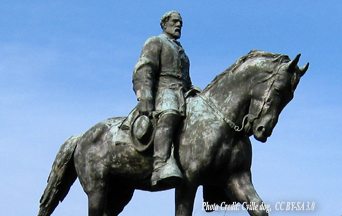
Everyone is familiar with the tragedy at C-ville in Virginia. Protesters against the removal of statues of Confederate figures clashed with counter-protesters — resulting in one death. The media have turned the event into a watershed for change.
Indeed, the tragedy at C-ville has been a catalyst for many cities to remove their statues — even in the dead of night. Empty pedestals now stand as silent testimony that the new keepers of the culture know what’s best for America. They stand ready to cleanse the public square of the memory of any person who they deem unworthy.
And that is the great problem. Who are these new keepers for the culture. What is their criteria for what is worthy for the nation?
 Learn All About the Prophecies of Our Lady of Good Success About Our Times
Learn All About the Prophecies of Our Lady of Good Success About Our Times
Who knows? But one thing is certain. From the removal of Civil War figures, it’s a small step to the nation’s Founders. Many are already calling for statues of the Founders to come down. After all, these rich slave-holding men enshrined slavery in the Constitution, and therefore their memory must also be blotted out. And what of the statues of saints venerated by the Church? There was the case of Saint Joan of Arc in New Orleans, in which someone spray painted the words “tear it down.” It appears that no one, saint or sinner, is immune from the wrath of the self-appointed iconoclasts.
Thus, C-ville has generated a storm in which no one is safe.
Rejecting Charlottesville’s Namesake
What about C-ville itself? Should it be allowed to exist unmolested?
C-ville is the name that perhaps should be given to what is now called Charlottesville.
Everyone knows that Charlottesville was named for Sophia Charlotte, queen consort of King George III of England. History teaches that the policies of George III were the cause of the American Revolution. During his reign in America, slavery and the slave trade flourished in all thirteen colonies. He imposed taxes upon the colonists and denied them representation. He waged war against the colonies for eight long years. He opposed Catholic emancipation in his realm. If anyone should be denied representation on the public square, it should be George III or anyone associated with him.
“Museums and galleries of art are undoubtedly necessary for the preservation of valiant heritages; if these were lost or destroyed, they could never be replaced. … We sustain the idea that the artistic and historical works of art should remain in the places for which they were created. To displace them … [to] the privileged walls of a museum in a large city on the infrequent occasions that they are visited requiring expenditure and inconvenience, then actually only a few people benefit. As a consequence of this tendency of our times, the gradual process of an unconscious assimilation of culture that prevailed in the past no longer exists.”
Memoirs of Pope Pius X, by Cardinal Merry del Val, pp. 79-80.
Surely, his wife must have known about his policies and profited from them. And yet, there is no record that she protested about these things to her husband during the course of their fifty-year marriage. In fact, history suggests Charlotte was a source of great strength and support for George III, who suffered from many ailments.
Thus, the demand that Charlotte’s name be stricken from the city’s name is justified. It should be called C-ville to demonstrate the city’s rejection of its wretched patron. Let the “C” remain like an empty and ugly pedestal for all to see the great uprightness of the city citizens who took this great step. Not that the citizens need to be consulted, it’s enough that C-ville simply be declared, perhaps through a late-night tweet by the mayor.
History Records the Deeds of Peoples in all Conditions of Life
But why stop at C-ville? Further south in North Carolina, a city still has a similar C-name. And what of Virginia named after a problematic Elizabeth I? All across the nation, there are statues, cities and places that are named after people that were far from perfect.
Such revisionist actions, if successful, will spell the end of history. For history is that fascinating narrative that records the deeds of peoples in all conditions of life. It records their tragedies, their accomplishments, their defeats and glories, their hopes and misfortunes. It’s the tale of the constant fight between good and evil. This drama will continue unto the end of the world.
History is not written only in letters but in statuary, places and culture. History is not meant to record stories of the perfect. If it were, the history books would be like blank and ugly pedestals recording nothing.
As seen on The Stream.
